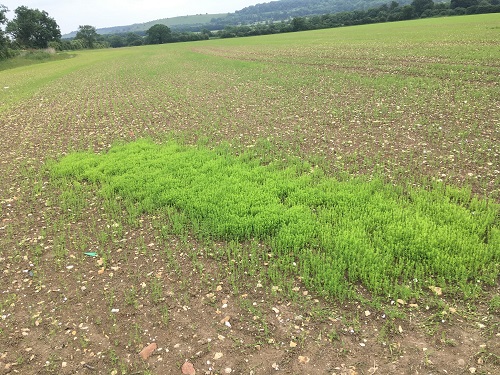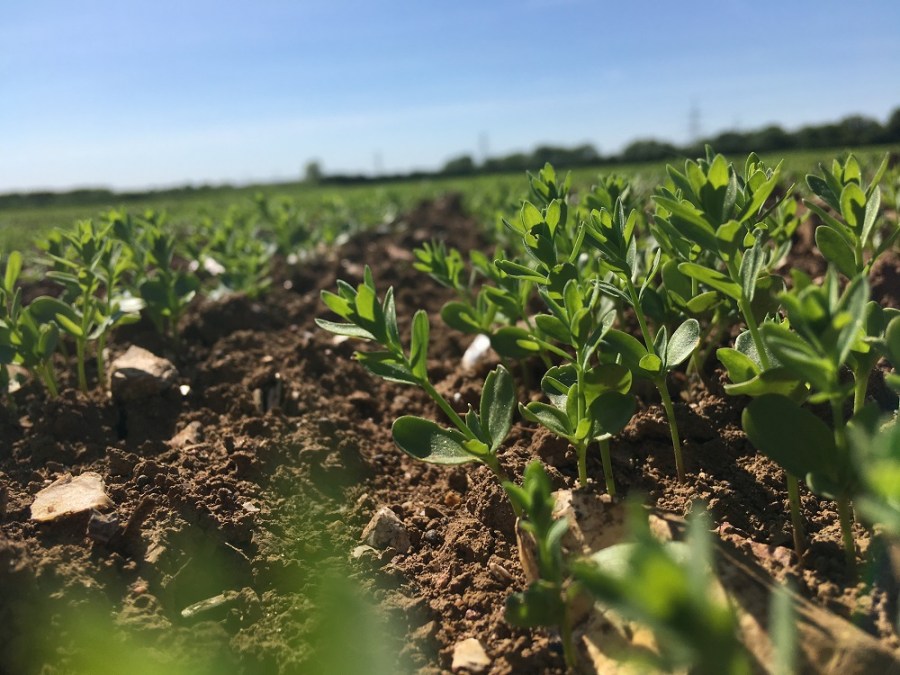The secret to a successful winter linseed crop lies in its establishment. CPM finds out how growers are helping plants get their roots down for the winter.
You’re aiming for 450 seeds/m2 which is lower than for spring linseed because the winter crop will tiller more.
By Lucy de la Pasture
As autumn-sown crops go, winter linseed is about as simple as they get. The only real requirement to ‘do’ anything is in getting the establishment right, says Hannah Foxall, agronomist for Premium Crops.
“The success of winter linseed is all about getting the optimum plant stand and establishing a crop that isn’t too lush going into the winter. Plants do need to get their roots down so paying attention to seedbed conditions is very important,” she says.
“Once the crop is established, there’s time for winter cereal volunteer control and a fungicide application. No insecticide is required because winter linseed isn’t affected by flea beetle,” she explains.
Hannah’s tip is to make sure linseed isn’t drilled into high levels of trash. “If there are large amounts of straw residues, the linseed plants can struggle to come up through it. That extra centimetre before reaching the surface can make a big difference as well as lock up nutrients.”

By paying close attention to detail at drilling, accidents such as this and overlaps can be avoided.
A straw rake provides an easy solution to any residue problems and is something machinery innovator and grower Jeff Claydon employs to good effect on his farm in Suffolk.
His Opti-till approach is one Jeff describes as occupying the middle ground between no-till and min-till systems. “You’re going directly into the stubble but are moving enough soil to create a strong rooting zone,” he explains.
“We go in with our Claydon Straw Harrow five days behind the combine to break up and spread the chopped straw and trash. The straw harrow produces a shallow tilth of 2-3cm, just enough to encourage the germination of volunteers. We then go in again with the straw harrow, repeating the pass every 10 days or so. By drilling time we’ve had 4-5 flushes of weeds and have spent less than the cost of spraying with glyphosate,” he comments.
Jeff stops harrowing two weeks in advance of drilling to allow the stubbles to green up again before applying 2.5-3 l/ha glyphosate in front of the drill to give crops a clean start.
Another grower who is participating in the Linseed Challenge has suffered the consequences of leaving too much straw residue on his soil surface. BASIS and FACTS qualified, Tim Payne grows winter linseed on his farm near Kings Lynn in Norfolk, in a rotation which includes winter wheat, winter oilseed rape, sugar beet and spring barley.
“Winter linseed doesn’t like chopped straw in the seedbed so if it’s not properly incorporated then you have a problem. This year we’ve baled the straw in front of the linseed crop so we have a clean stubble to drill into.”
Tim adopts a min-till approach on his farm and is moving towards direct drilling but confesses to not being there yet. Having taken over the farm recently, he’s witnessed the effect that over-working the ground can have on the winter linseed crop.
“From the yield maps on the combine it was plain to see the areas in the field where soil had been overworked and then slumped during the winter. The headlands were particularly poor yielding, but the main areas in the field were consistently yielding 3.5-4t/ha.
“I’m now taking a more managed approach to tillage with the aim of doing as little to the soil as possible while producing a clean seedbed. Getting out with the spade is key and if the soil needs attention then I will work it,” he comments.
His general approach to stubbles is to make a pass with Tillso Ultralite tines retrofitted to an existing
cultivator to remove any soil compaction in the main rooting zone. The idea is to deliver a sustained
restructuring pass with minimum surface disturbance, he explains.
Tim plans to direct drill part of his winter linseed crop this autumn with his Weaving GD drill
alongside his usual approach so he can assess any differences in establishment.
Monmouthshire grower Nick Turner farms 162ha near Raglan and winter linseed has now replaced some of his OSR acreage. As a mixed farming enterprise all the straw is baled, so residues aren’t a problem in his more traditional establishment system using deep cultivations.
“Straw is at a premium this year and we even sold our linseed straw to a local dairy farmer which has added a bit of extra margin to the crop,” he comments.
Hannah cites Nick as a grower who consistently achieves good linseed establishment in the autumn and he puts this down to his plough and combination drill approach, which on his clay loam soils produces really consistent results, he says.
One thing all three growers have in common in spite of their different tillage approaches is making sure the winter linseed has an easy rooting zone and, all-importantly, consolidating the seed bed after the drill.
Hannah stresses the importance of good seed to soil contact with a small seed like linseed and highlights that a cloddy seed bed can be the crop’s worst enemy. “A uniform, consolidated soil surface will result in more even germination and better herbicide efficacy, particularly as autumn weed control is reliant on residual herbicide activity,” she adds.
The ideal drilling window for winter linseed is during Sept and is governed by the state of the soil. “It’s important to wait for the right soil conditions, but as a guide the winter crop should be drilled by mid-Sept in the North, 25 Sept in the Midlands and 30 Sept in the South of the UK.
When it comes to seed rate, most linseed is pre-packed in bags to sow 0.5ha at the optimum rate. “You’re aiming for 450 seeds/m2 which is lower than for spring linseed because the winter crop will tiller more,” advises Hannah.
Tim has found that using a variable seed rate has helped him achieve much better establishment on his varying soil types. He uses soil mapping and conductivity tests carried out by Soyl to make a variable seed rate plan for his winter linseed. The variable rate system has improved his plant counts from 55% to within a few percent of the optimum, he says.
Jeff prefers his Opti-drill which puts a leading tine in front of an A-share seeder followed by a levelling board, with or without harrows. “The leading tine lifts and aerates the soil, creating the rooting-zone and a drainage channel, and for winter linseed should work at a depth of about 10cm. The seed is deposited at a depth of 2-3cm in a band of 12.5-15cm and linseed plants come up like little hedgerows,” he notes.
Jeff believes the very shallow tilth produced in the Opti-till system gives seeds the best possible chance of germinating because it’s being placed onto the moisture shelf, where the tilth meets the undisturbed soil underneath. Capillary water is drawn up through the soil to the ‘shelf’ and the humidity is maintained by crumbly soil containing organic matter above the seed.
“Seeds generally germinate with 48 hours resulting in a good plant stand and competitive crop. Most importantly, you’ve invested in the seed and have established the crop using just 15 l/ha of diesel. That means in a difficult season you haven’t over-invested,” he says.
Many winter linseed crops won’t require applications of P and K in the autumn unless soil indices are very low, Index 0 or 1, says Hannah. Tim’s soils span the full range of soil indices so he does apply seedbed P and K, though uses variable rate application to make sure he’s only applying as much as is necessary.
Of the micronutrients, zinc is the main one to consider in the autumn and can applied any time from emergence to help promote rooting and branching, adds Hannah.
Both Tim and Jeff have farms where blackgrass can be problematic if not managed well. Jeff believes that if blackgrass populations are at a high level then it’s better to opt for a spring-drilled linseed crop.
“You can spend the autumn removing blackgrass with the straw harrow and glyphosate. Going the mechanical route helps reduce the resistance risk by saving on the number of glyphosate treatments needed before drilling spring linseed,” he adds.
For control of blackgrass there are multiple chemical options available, says Hannah. “Avadex (triallate) granules can be applied immediately after sowing and followed by post-emergence herbicide, Centurion Max (clethodim) to take out any blackgrass that comes through the pre-em treatment. Residual post-em herbicide Crawler (carbetamide) provides a further option for blackgrass control later in the autumn.”
Tim confesses that he hasn’t always managed his blackgrass to best effect in the winter linseed, though he’s not convinced his populations have affected his yields. But he intends to use Avadex for the first time this season on his linseed to help keep on top of the blackgrass population.
Nick doesn’t have to consider blackgrass on his farm and believes his traditional cultivation approach has helped keep the grassweed from becoming established. “We find winter linseed is a very easy crop to grow. It gets going well because there’s heat in the soil and day length is still reasonably long. Our only input in the autumn is a pre-em herbicide Callisto (mesotrione) for broadleaf weeds,” he says.
Trial investigates factors affecting linseed yield
The Linseed Challenge was created to push the linseed yield boundaries and facilitate the sharing of knowledge. As part of this Premium Crops are investing in plant physiology and agronomy trials, says Hannah.
“This year one of the trials looked at either the application of a late fungicide or nitrogen application at flowering, replicating work previously done on oilseed rape. Like OSR, linseed’s yield is laid down from flowering onwards and these trials aimed to test whether yield could be improved by prolonging the green leaf area.
“Yield responses were inconclusive but given the lack of water during the trial, it’s not known if the results were due to a lack of moisture reducing the translocation of fungicides or uptake of nitrogen. However, pictures from the trial of the combination of fungicide and nitrogen did show a greening effect. As a result, the trial will be repeated next year,” she concludes.
The Great Linseed Challenge
As part of a drive to support and encourage linseed growers, Premium Crops and CPM have teamed up in a quest to find the UK’s best growers and agronomists of this highly under-rated crop. Linseed is often regarded as a low yield crop, but competing growers have shown there’s real potential to showcase.
There are three categories:
- Best net margin per hectare – Prize: A Mavic Agri Pro drone package
- Best overall yield – Prize: A holiday for two to northern France
- Best innovation in linseed agronomy – Prize: 2x £250 voucher for an Artis training course.
A panel of judges have been making final assessments of both winter and spring linseed crops. Results are still being assessed – CPM and Premium crops will announce the winners at next year’s Cereals event.
Further details can be found at: www.premiumcrops.com.





